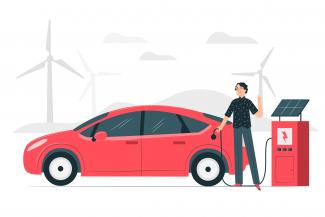There is no industry that could function without electricity. How to protect yourself against lack of power from the grid? After all, various types of vehicles move without the need for "power supply from the cable". Yes, it is the electricity storage that allows for flexible use and supply energy to any place. It can ensure the continuity of machine functioning in case of any failures. Its basic functionality is ensuring constant voltage supply. This is one of the ways to guarantee energy security. I know that, and are you aware of that? Let's try to follow this together and explain some ideas further.
Automotive History
When asked: what was first – a combustion engine or an electric engine, most of you will probably answer – a combustion one, of course. Well, not quite! It is said that the pioneer of the invention of cars with internal combustion engines in their current form was Carl Benz. It was him who in 1885 created his internal combustion vehicle and began the era that continues to this day. Was the electric vehicle constructed before? Of course it was. Depending on the sources, the year 1836 or 1842 is assumed to be the beginning of what we see now – an era in which the vehicle is powered by an electric motor from the energy storage.
Did you know that 4 out of 10 vehicles in the 19th century were electric ones? Did you know that already then they reached speeds close to 100 km/h? Of course, due to the costs, there was a later expansion of combustion engines. So, what is the situation today? We are striving for a sustainable, ecological approach and therefore: the efficiency of the old type of bulb (with tungsten filament) is about 5%. What does this mean? Only 5% of the 100% energy is used for its essential functionality– light generation. The remaining 95% is irretrievably lost in the form of heat energy (the bulb heats up).
As in the case of cars– let's start our analysis with those with internal combustion engines – the ones powered by gasoline have efficiency of 40%. Diesel engines have an efficiency of 50%. Is that a lot? Imagine that from every glass of tea you spill half of it. From each salary you only get half. So what can you do to make it better? Electric drive – this is how it becomes the main star here, and its 90% efficiency allows you to look into the future with confidence. The use of such a drive means that only 10% of energy is irretrievably lost and cannot be used for the purpose of moving. So please note that purely theoretically on the same portion of energy the electric engine will take us twice as far. This is obviously the future, but we can already touch, see and try this future today. Not without problems, but I will write about it later in this article.
Energy storage
Today, many different types of energy storage are used to store energy. Some may be linked to systems that enable the generation of energy from renewable sources, such as solar or wind energy. Unfortunately, both of them occur temporarily (not continuously) and prevent the systems from being permanently supplied. Therefore, we need the systems that will enable continuous storage of energy and then supply it to the device when needed.
Types of energy storage include:
-
FES – Flywheel Energy Storage;
-
SMES – Superconducting Magnetic Energy Storage;
-
FC – Fuel Cells; batteries, supercapacitors and other.
Flywheel Energy Storage converts electrical energy into mechanical energy and stores it in the "mass of the rotating flywheel". The energy in Superconducting Magnetic Energy Storage is stored in a magnetic field, produced by direct current. Fuel cells are electrochemical energy storing places acting as a result of the chemical reaction of hydrogen with oxygen. A by-product of its operation is water. Batteries are nowadays one of the most frequently used energy storage devices. The energy stored in their volume is in the chemical form. Supercapacitors are devices for storing energy in an electric field – these are basically very large capacitors.
Comparison of batteries and supercapacitors
From the above mentioned ways of energy storage, the batteries are most frequently used in vehicles. The battery stores energy in the "electrolyte". This allows to store a relatively small volume of energy. It is said that the energy density, i.e. the amount of energy stored in a unit of mass is about 100Wh/kg. It is this amount that means exactly how much energy can be stored in the battery.
The second important parameter is the power density – for a battery of 100W/kg. What does this unit tell us about? It is the ability to supply energy in a unit of time. The larger it is, the faster the energy can be discharged and of course recharged. Can we achieve more? Of course we can. The supercapacitor, though there are still no better parameters in terms of energy density than the battery, already today can boast 100 times higher power density. What does this mean? When used in vehicles, we can treat it as a huge store place of energy, which is easy to fill during braking, and when there is no power supply from another source, it is an excellent energy reservoir. It is in the direction of the application of supercapacitors that the work of scientists will develop. They can be the successors of the batteries.





